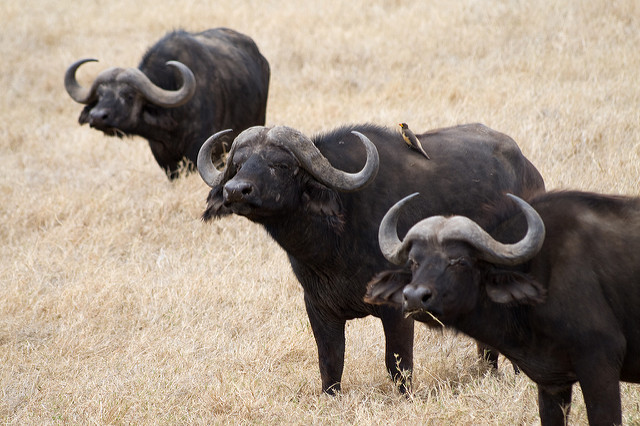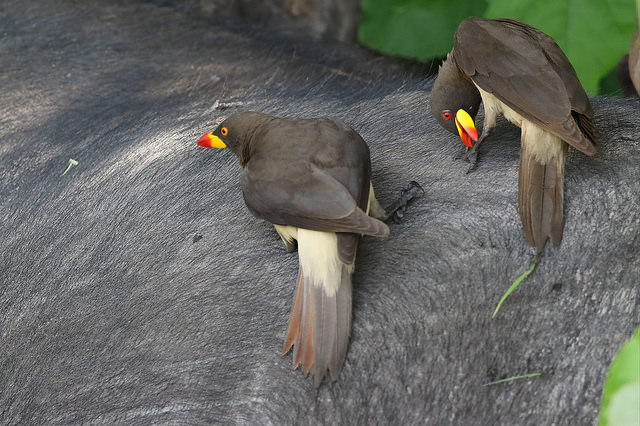African buffalo, also known as Cape buffalo, are striking to see in person. Thanks to its large stature and enlarged horns, they can be quite intimidating. But did you know there’s a few interesting things about them that separates them from other bovine animals? Put your knowledge to the test and don’t have a cow, man. Here are six things you didn’t know about African buffalo.

Courtesy of Stig Nygaard/Flickr.com
They’re extremely dangerous
They may look similar to cows, but down plan on tipping them. They’re so harmful that they’re considered part of the big five game animals, elbowing next to lions and leopards. In fact, they might be the most dangerous of them all and it’s estimated that about 200 people per year are gored to death by the temperamental creatures. The buffalo are known for their surprise tactics where they can completely blindside unsuspecting humans by going behind them to pummel them to their death. Even the largest crocodiles know not to mess with these dangerous animals and will take their chances for a meal elsewhere.

Courtesy of Bernard DUPONT/Flickr.com
They have a mob mentality
If a lion (brave, yet stupid) decides to try its hand at killing a calf, she’ll be messing with the wrong clan. When a buffalo is threatened, they’ll gang up and attack in groups against the predator. Because of their incredible support of each other, buffalo are thriving in the wilds since they have very few predators, and the ones that do attack, have little chances of successfully making a kill. In other words, in the animal kingdom, the African buffalo the ones you want as your bodyguard.
They only mate and give birth when it rains
Talk about being only happy when it rains. Buffalo have a weird mood when it comes to the weather and during rainy season, they will get down to business. A female usually will give birth by the next rainy season. Their pregnancies last longer than humans and will have a gestation period of 11.5 months (almost a full year!). When a female is in heat, she will be selected by a male who will guard her to keep other bulls away. By the time the calves are born, they tend to stay close with their mothers until they are about two year olds, much longer than most young mammals.
The herds are controlled by females
Although a female won’t lead the herd, the dominant male is “bossed” around by females that will vote in wherever direction they wish to travel to. When migrating, the females will “vote” by forming together to go in the direction they want, leaving the males no choice but follow them or get left behind. The famous quote from My Big Fat Greek Wedding rings true in this, “The man is the head of the house. But the woman is the neck, and she can turn the head whichever way she pleases.”

Courtesy of Henrik Sommerfeld/Flickr.com
They’re carriers of quite a few diseases
They appear strong and valiant as ever but sadly, they’re extremely vulnerable to cattle-borne diseases. You’ve probably heard of mad cow disease, but the buffalo are prone to have sleeping sickness that’s transmitted to them by tsetse flies. Despite the name, the disease will give a buffalo trouble with sleeping, a constant state of lethargy, and poor coordination until their demise. In fact, in the 1890s, a rinderpest plague almost made the African buffalo extinct since the pandemic killed off 90% of them (along with many species of antelope). Since then, they recovered and population went up, but conservationists are always concerned of any possible unexpected plague that could threaten their existence again.

Courtesy of Derek Keats/Flickr.com
Birds are their friends
If you spot African buffalo on safari, you might see a few birds lounging on their backs. You’d think they’d be the most annoying thing to them, but buffalo are grateful for them. The oxpeckers will eat flies and ticks off their backs, helping them combat diseases transmitted by the pests. The odd relationship the giant, violent animals have with the the fragile birds is special as they assist each other in their survival.
More from AFKTravel:
6 Things You Didn’t Know About The Elephant Shrew
6 Things You Didn’t Know About The Agama Lizard
6 Things You Didn’t Know About Bongos
Want to discover the finer side of Africa? Sign up for our weekly newsletter.

